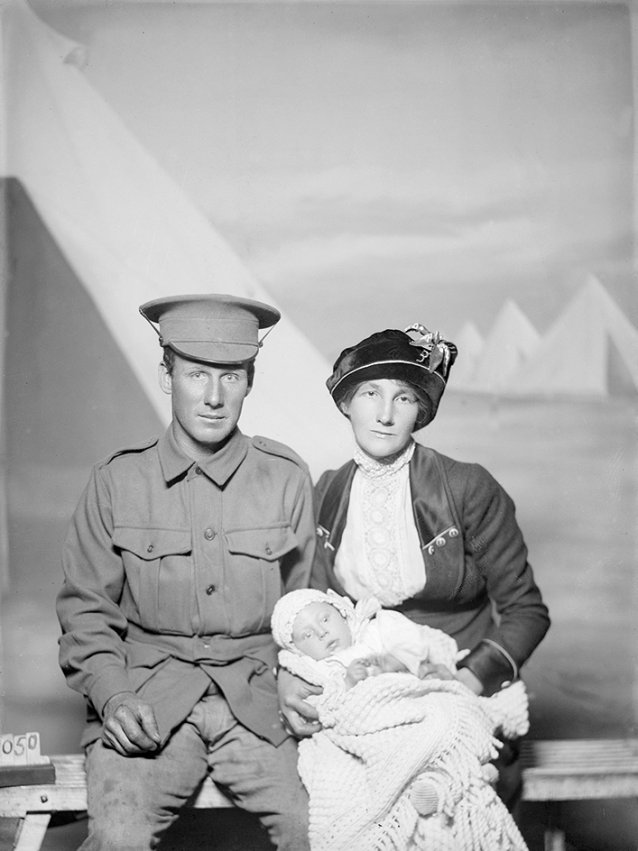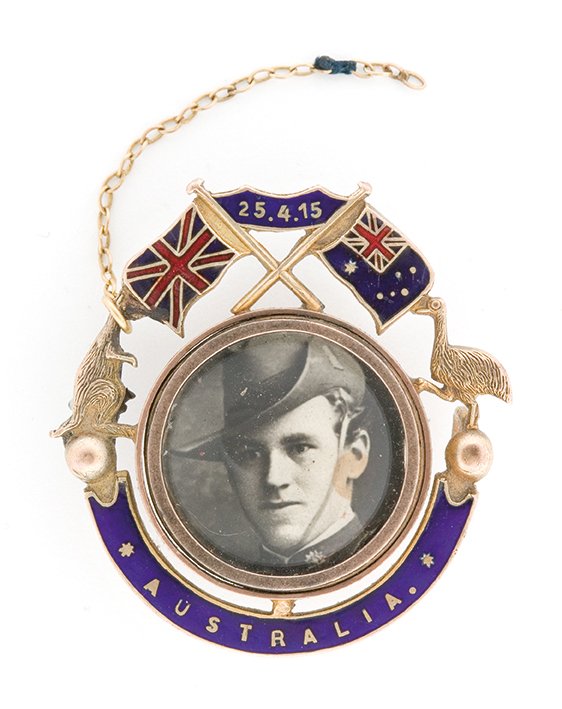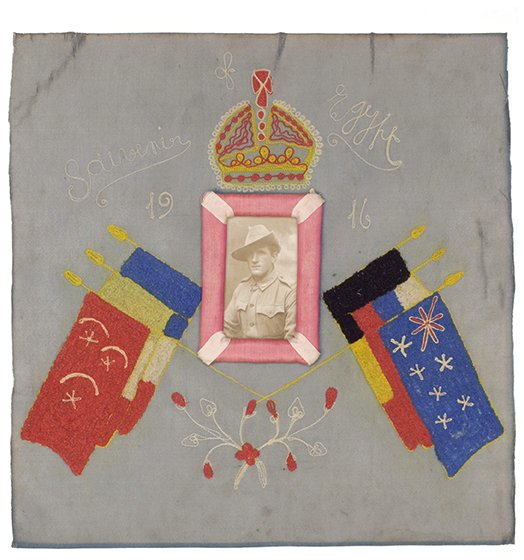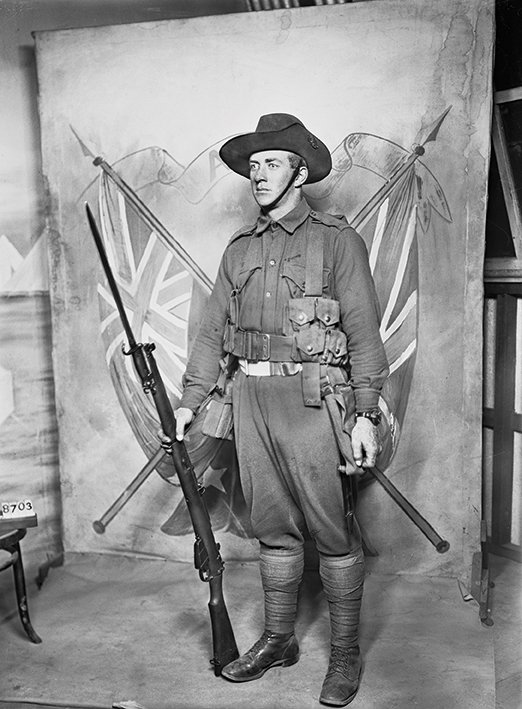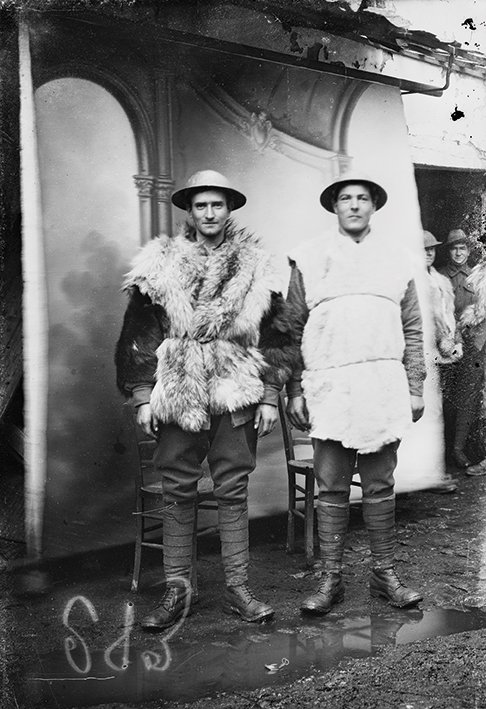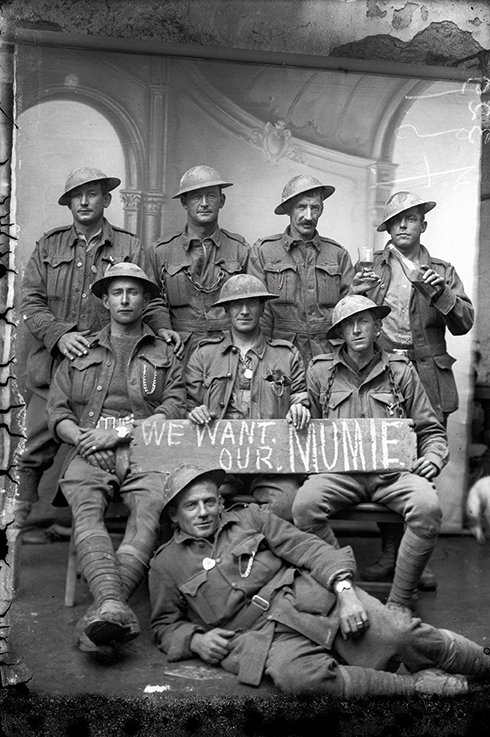The portrait of George and Nellie Swanton with their baby daughter, Joan, hung in the family home in Melbourne for decades. George, an engine driver, had enlisted in the Australian Imperial Force (AIF) in March 1915. A few weeks later, while he was receiving the most rudimental of military training at Broadmeadows camp, he and his family sat for their portrait, taken by a photographer from the Darge Photographic Company. It was likely one of the last times they were all together. In May, George embarked from Australia for overseas service. He served in the Gallipoli campaign, but on 28 July, 1916 the thirty-four year-old corporal died in France from wounds suffered at Pozières during the battle of the Somme.
Final frame
by Karl James, 7 December 2016
Joan Swanton grew up looking at this family portrait; it was one of the few images she had of her father. Another, taken shortly before he left for overseas, hung in her bedroom. Three of her uncles were also killed during the war, and another returned wounded. Her mother never remarried. As Joan was to later recall, she grew up in a home full of mementos from the war.
Such stories were all too common in Australia following the Great War. So too were the ubiquitous photographs, hanging on the mantelpieces and in the hallways and bedrooms of tens of thousands of family homes, depicting the men lost during that terrible conflict. Soldier portraits have become familiar images of the period. Just like ‘selfies’ today, soldiers posed individually and in groups to capture specific moments or create a visual record of significant occasions. These photographs were widely circulated amongst family and friends, becoming keepsakes or souvenirs sent home to Australia from Egypt, France or Belgium. As casualties mounted, however, some used portraiture as a public statement of support for the war effort, and the genre also became associated with private rites of mourning.
Even in 1914, soldier portraiture in Australia was not new. One of the earliest known photographs of a military subject was taken in Australia in May 1861, showing members of the 1st Regiment, New South Wales Rifle Volunteers, formed up at Sydney’s Victoria Barracks. Throughout that decade, the military as subject matter became popular with professional and amateur photographers alike.
In 1885, the colony of New South Wales sent a military contingent to join British forces fighting in the Sudan. In July, the Sydney photographer Barcroft Boake offered to individually photograph the recently returned soldiers, and to present these images to the Colonial and Indian Exhibition in London. Boake combined 278 studio portraits into one vast mosaic, measuring over two metres wide, and nearly as tall. It was later presented to Queen Victoria, who, according to the Sydney press, was ‘much pleased to accept’.
For those soldiers included in the project, Boake’s photomontage was a public acknowledgment of their service in the Sudan and the colony’s commitment to Britain and the Imperial cause. For Boake, it also constituted a spectacular form of promotion. The mosaic was referenced frequently in the press, and, during the late 1880s, Sydneysiders were encouraged to view a duplicate in Boake’s George Street studio. (The original remained in London and was returned to Australia during the Second World War).
At the turn of the century the Australian colonies again made military commitments overseas, joining British forces in China during the Boxer Rebellion, and in South Africa during the Boer War. And by August 1914 the British Empire, including Australia, was once again at war.
With only a small navy and no regular full-time army, Australia raised the AIF to send troops to fight in the Great War; from 1914 to 1918, some 330,000 Australians served overseas. An all-volunteer force, the AIF’s members came from many different backgrounds. They included men like George Swanton and his brothers – working-class men who joined the army out of a sense of duty, obligation, adventure, and economic necessity, or as a result of social pressures and coercion, or even out of guilt.
Tens of thousands of men went into training camps across the country. In addition to learning basic military drill and how to march, sitting for a studio portrait was an obligatory pastime for new recruits. As a lady visiting Broadmeadows camp in early 1915 observed, amid the endless lines of tents, whitewashed stones, and men marching, digging, and cooking, ‘the ubiquitous photographer’ was now a permanent fixture in the camp.
With the government granting concessions to a few studios to photograph the AIF, the war proved quite lucrative for some photographers. Both Crown and Nada Studios on George Street in Sydney were awarded concessions, as was Alice Mills, who had a studio on Collins Street in Melbourne. Algernon Darge, however, was perhaps the best-known soldier portraitist. During the war, Melbourne’s Darge Studios photographed some 11,000 soldiers in individual or group portraits, as well as some 9,000 images of life at Broadmeadows camp. These images were produced as large prints and postcards, and made available for sale to the soldiers and their families.
The advertising slogans employed by photographic studios of the time conveyed the meaning and purpose of these images to both subject and recipient: ‘Every man desires to leave a portrait behind so as to be remembered’; ‘A good photo will comfort those at home’; ‘Your portrait will be treasured by your friends if taken at Mackay Studio’. Accordingly, soldiers, sailors, and nurses were photographed individually and in groups with their loved ones, and these mementos were widely circulated throughout the war between the men and nurses abroad, and their families and friends back home.
Demonstrating both patriotism and self-promotional zeal, the Melbourne paper Punch worked with Darge Studios to supply soldiers at Broadmeadows camp with a free photograph prior to their embarkation for overseas service. Perth’s Sunday Times made similar arrangements with Dease Studios on Barrack Street. Many of these portraits were reproduced in the press as the war progressed, and soldiers all too often became casualties. Throughout the war, newspapers, newsletters, and other publications published the portraits of local soldiers killed, wounded, or missing overseas on a near-daily basis.
While such studio portraits were intended to be private – sometimes even intimate – tokens, as the war continued, they became more public. The efforts and sacrifices of individuals were recognised as part of an overarching national story. Portraits with ornate, hand-painted embellishments were displayed in homes and workplaces, accompanied by patriotic phrases. Sentiments such as ‘He heard the call and answered’ and ‘For King and country’ were popular.
As with Boake’s photomontage some thirty years earlier, soldier portraiture was used to publicly acknowledge both an individual’s contribution and the sacrifices of the community as a whole. Recognising this significance in October 1918, the board of governors of, respectively, the Public Library, Museum, and Art Gallery of South Australia announced an initiative to collect a photograph of each uniformed soldier in the state. Soldiers were encouraged to be photographed for free at the studios on Rundle Street in Adelaide.
Overseas, the popularity of portraiture continued unabated. Australian ‘diggers’ were well paid when compared to the British ‘tommies’, and the men and women of the AIF were ready consumers in Egypt, Britain, France and Belgium. As well as established studios in Cairo, entrepreneurial photographers operated mobile photographic studios in front of the Sphinx, the pyramids and other landmarks. Postcard prints were extremely popular, as were portraits embroidered onto silk handkerchiefs or framed in embroidered cloth.
The glass-plate negatives of Louis and Antoinette Thuillier, rediscovered in a French farmhouse in 2011, are the most striking and perhaps most candid portraits of Australian soldiers during the Great War. The Thuilliers turned their farmhouse in the village of Vignacourt into an amateur outdoor studio, and advertised for nearby soldiers to come and have their photographs taken.
Neighbouring the strategically important city of Amiens on the Somme River in northern France, Vignacourt was out of range of the German artillery but close enough to the front lines to play an important role as a staging point, casualty clearing station, and billet area. French, British, Australian, Indian and American soldiers, and Chinese labourers passed through the village at different times throughout the war, and several thousand were photographed by the Thuilliers, including some 800 Australians.
Having fought through the terrible battle of the Somme in 1916, Australian soldiers were billeted in and around the village during the freezing winter of 1916-17. Unlike the fresh, clean, and carefully posed faces of the Darge Studio portraits, the soldiers photographed by the Thuilliers are hard men – combat veterans with battered hats, muddy boots, and worn tunics. Many remain unknown, but the strain and fatigue is evident on the faces of all. So too is the infamous diggers’ humour, with the portraits often constituting personal mementos for soldiers depicted with their ‘mates’.
Australians were once again billeted in Vignacourt when the war ended on 11 November, 1918. The news of the Armistice was met with singing and dancing; the villagers ‘opened their cellars and wine flowed among the troops’. This sense of celebration was also captured in the photographs of the time.
Over 60,000 Australians were killed during the Great War, and about a third of those lost have no known grave. The families of the dead and missing had no means to visit the graves and memorials on Gallipoli or the Western Front; in the absence of these sites, soldier portraits assumed an even greater significance to the bereaved. They often represented the final likeness of those killed – sometimes the only known likeness. Framed portraits were unveiled during memorial services and became the focus of commemorations. Photographs were also reproduced in jewellery and memorial cards.
For Julia Emsley, a studio portrait of her and her son, Private Harry Emsley, was a treasured possession. Harry was thirty-three and working as a labourer in Western Australia when he enlisted in early 1917 (his younger brother was already serving in the AIF, and in April was wounded and became a prisoner of the Germans). Harry arrived in Franceb in early 1918, and was killed during the battle of Amiens on 8 August. He has no known grave. Following his death, another Australian soldier found the photograph of Emsley and his mother, taken in Adelaide before his departure, along with a bullet-mutilated army-issue writing pad near some recently dug graves. The soldier sent the items home to South Australia, whereupon, after an investigation by the Daily Herald newspaper, they were forwarded to Mrs Emsley. She greatly treasured the photograph, knowing that her son had kept it with him ‘to the end’.
A hundred years after the Great War, soldier portraiture has assumed new meaning. The men and women photographed by Algernon Darge, Louis and Antoinette Thuillier, and countless others have become central to the commemoration of the centenary of the Great War. Each portrait represents an individual life and a family affected by the vast conflict. Each allows us to remember Australia’s commitment to, and sacrifice in, the terrible tragedy that was the First World War.
We acknowledge the Australian War Memorial, Canberra for graciously providing the images for this article.
Related information



Portrait 54, Spring 2016
Magazine
Explore an Indian treasure trove, photography by Robert McFarlane and Nan Goldin, Michael Taylor's expressionist paintings, the Great War portraits, and more!



Love scars
Magazine article by Katrina Osborne
Katrina Osborne immerses herself in one of photography’s most fearless chronicles.
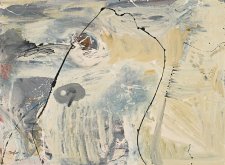
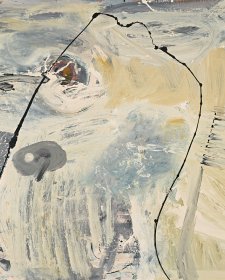
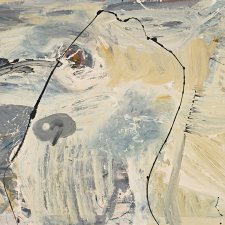
Living landscape
Magazine article by Gillian Raymond
Gillian Raymond ponders landscapes as self-portraiture in Michael Taylor’s intimate expressionism.
